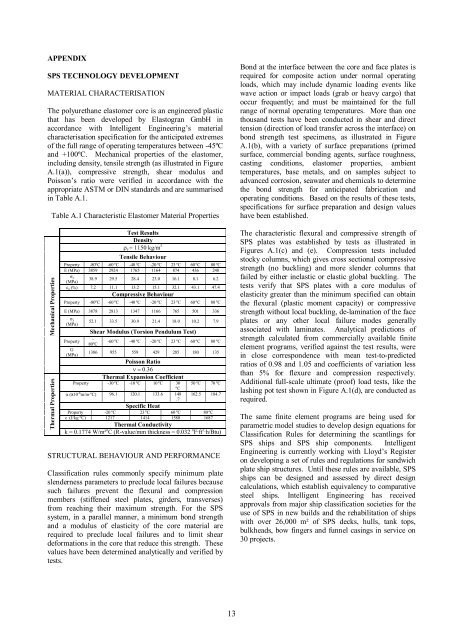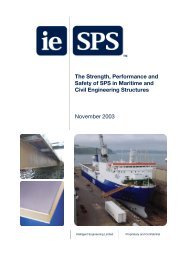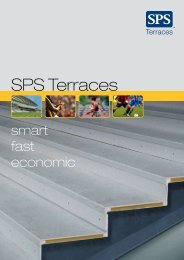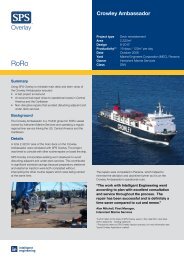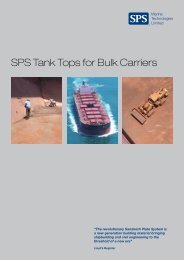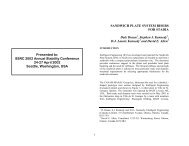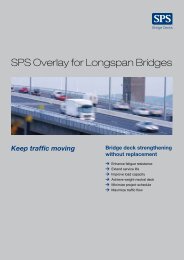The Performance, Safety and Production Benefits of SPS Structures ...
The Performance, Safety and Production Benefits of SPS Structures ...
The Performance, Safety and Production Benefits of SPS Structures ...
Create successful ePaper yourself
Turn your PDF publications into a flip-book with our unique Google optimized e-Paper software.
APPENDIX<strong>SPS</strong> TECHNOLOGY DEVELOPMENTMATERIAL CHARACTERISATION<strong>The</strong> polyurethane elastomer core is an engineered plasticthat has been developed by Elastogran GmbH inaccordance with Intelligent Engineering’s materialcharacterisation specification for the anticipated extremes<strong>of</strong> the full range <strong>of</strong> operating temperatures between -45ºC<strong>and</strong> +100ºC. Mechanical properties <strong>of</strong> the elastomer,including density, tensile strength (as illustrated in FigureA.1(a)), compressive strength, shear modulus <strong>and</strong>Poisson’s ratio were verified in accordance with theappropriate ASTM or DIN st<strong>and</strong>ards <strong>and</strong> are summarisedin Table A.1.Mechanical Properties<strong>The</strong>rmal PropertiesTable A.1 Characteristic Elastomer Material PropertiesTest ResultsDensityρ e = 1150 kg/m 3Tensile BehaviourProperty -80 o C -60 o C -40 o C -20 o C 23 o C 60 o C 80 o CE (MPa) 3859 2924 1765 1164 874 436 248σ y(MPa)38.9 29.5 28.4 23.0 16.1 8.1 6.2ε u (%) 7.2 11.1 13.2 15.1 32.1 43.1 47.4Compressive BehaviourProperty -80 o C -60 o C -40 o C -20 o C 23 o C 60 o C 80 o CE (MPa) 3878 2813 1347 1166 765 501 336σ y(MPa)52.1 33.5 30.9 21.4 18.0 10.2 7.9Shear Modulus (Torsion Pendulum Test)Property-80 o C-60 o C -40 o C -20 o C 23 o C 60 o C 80 o CG(MPa)1386 955 559 429 285 180 135Poisson Ratioν = 0.36<strong>The</strong>rmal Expansion CoefficientProperty -30 o C -10 o C 10 o C 30 50 o C 70 o Co Cα (x10 -6 m/m·oC) 96.1 120.1 133.6 148 162.5 184.7.7Specific HeatProperty -20 o C 23 o C 60 o C 80 o Cc (J/kg·oC)1217 1414 1588 1687<strong>The</strong>rmal Conductivityk = 0.1774 W/m² o C (R-value/mm thickness = 0.032 o F·ft 2·h/Btu)STRUCTURAL BEHAVIOUR AND PERFORMANCEClassification rules commonly specify minimum plateslenderness parameters to preclude local failures becausesuch failures prevent the flexural <strong>and</strong> compressionmembers (stiffened steel plates, girders, transverses)from reaching their maximum strength. For the <strong>SPS</strong>system, in a parallel manner, a minimum bond strength<strong>and</strong> a modulus <strong>of</strong> elasticity <strong>of</strong> the core material arerequired to preclude local failures <strong>and</strong> to limit sheardeformations in the core that reduce this strength. <strong>The</strong>sevalues have been determined analytically <strong>and</strong> verified bytests.Bond at the interface between the core <strong>and</strong> face plates isrequired for composite action under normal operatingloads, which may include dynamic loading events likewave action or impact loads (grab or heavy cargo) thatoccur frequently; <strong>and</strong> must be maintained for the fullrange <strong>of</strong> normal operating temperatures. More than onethous<strong>and</strong> tests have been conducted in shear <strong>and</strong> directtension (direction <strong>of</strong> load transfer across the interface) onbond strength test specimens, as illustrated in FigureA.1(b), with a variety <strong>of</strong> surface preparations (primedsurface, commercial bonding agents, surface roughness,casting conditions, elastomer properties, ambienttemperatures, base metals, <strong>and</strong> on samples subject toadvanced corrosion, seawater <strong>and</strong> chemicals to determinethe bond strength for anticipated fabrication <strong>and</strong>operating conditions. Based on the results <strong>of</strong> these tests,specifications for surface preparation <strong>and</strong> design valueshave been established.<strong>The</strong> characteristic flexural <strong>and</strong> compressive strength <strong>of</strong><strong>SPS</strong> plates was established by tests as illustrated inFigures A.1(c) <strong>and</strong> (e). Compression tests includedstocky columns, which gives cross sectional compressivestrength (no buckling) <strong>and</strong> more slender columns thatfailed by either inelastic or elastic global buckling. <strong>The</strong>tests verify that <strong>SPS</strong> plates with a core modulus <strong>of</strong>elasticity greater than the minimum specified can obtainthe flexural (plastic moment capacity) or compressivestrength without local buckling, de-lamination <strong>of</strong> the faceplates or any other local failure modes generallyassociated with laminates. Analytical predictions <strong>of</strong>strength calculated from commercially available finiteelement programs, verified against the test results, werein close correspondence with mean test-to-predictedratios <strong>of</strong> 0.98 <strong>and</strong> 1.05 <strong>and</strong> coefficients <strong>of</strong> variation lessthan 5% for flexure <strong>and</strong> compression respectively.Additional full-scale ultimate (pro<strong>of</strong>) load tests, like thelashing pot test shown in Figure A.1(d), are conducted asrequired.<strong>The</strong> same finite element programs are being used forparametric model studies to develop design equations forClassification Rules for determining the scantlings for<strong>SPS</strong> ships <strong>and</strong> <strong>SPS</strong> ship components. IntelligentEngineering is currently working with Lloyd’s Registeron developing a set <strong>of</strong> rules <strong>and</strong> regulations for s<strong>and</strong>wichplate ship structures. Until these rules are available, <strong>SPS</strong>ships can be designed <strong>and</strong> assessed by direct designcalculations, which establish equivalency to comparativesteel ships. Intelligent Engineering has receivedapprovals from major ship classification societies for theuse <strong>of</strong> <strong>SPS</strong> in new builds <strong>and</strong> the rehabilitation <strong>of</strong> shipswith over 26,000 m² <strong>of</strong> <strong>SPS</strong> decks, hulls, tank tops,bulkheads, bow fingers <strong>and</strong> funnel casings in service on30 projects.13


